In several places on the island there are castles, ruins, ancient villas, towers and fortresses that prove the past and the history of Kefalonia.

CASTLE OF ASSOS
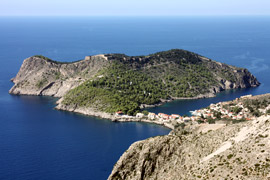 Together with Aghios Georgios, the castle of Assos is a fine example of military architecture of the island of Kefalonia. Together with Aghios Georgios, the castle of Assos is a fine example of military architecture of the island of Kefalonia.
The fortress of Assos was built by the Venetians in the sixteenth century fortified the top of the rocky hill, 170 m high, which occupies the entire peninsula of Assos.
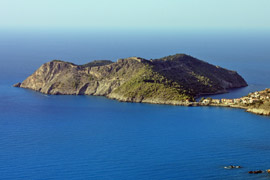 This peninsula that penetrates into the beautiful blue waters of the Ionian Sea, whose only access a narrow strip of land that connects the coast. This peninsula that penetrates into the beautiful blue waters of the Ionian Sea, whose only access a narrow strip of land that connects the coast.
The fortress of Assos was built as far back as 1584 the inhabitants of Cephalonia asked the Venetian authorities the establishment of a second after the castle of Agios Georgios for the most effective protection of the island of Kefalonia in the face of pirates.
The walls are about 2 km and the fortress has two doors, one leading along the eastern side and a smaller one to the south.
Today the ruins are preserved in massive walls, ramparts, the two gates, the residence of the Venetian superintendent and the Catholic Church of St. Mark.

CASTLE OF AGHIOS GEORGHIOS
The castle of Agios Georgios, in English St. George, is the oldest on the island of Kefalonia and is located in south of Argostoli, on top of the hill in the Livathos above Peratata.
It was first fortified by the Byzantines and, given its dominant position on the southwest of Kefalonia, watched the eventual landing of pirates and foreign invaders.
During Venetian emperor, a defensive wall was built with reinforced outer ramparts, and the people of the time she used to take refuge in times of danger. In 1757, when it became the capital of the island of Kefalonia Argostoli, the castle of San Giorgio begins to lose its importance and decay.
The Castle in the form in which it retains today appears to polygonal, with a perimeter of 600 meters and covers an area of 16000 square meters.
In the surrounding area we can still see buildings that represent the different periods in the history of the castle ruins of churches, stands with loopholes and patrol boats, tanks with the coats of arms of the Venetian nobility, various warehouses and the remains of a bridge connecting the stands, the below which there was a safety gallery that debouched in the lagoon of Koutavos.

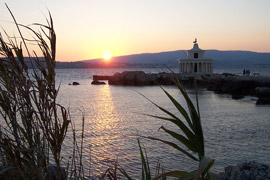 AGHII THEODORI LIGHTHOUSE AGHII THEODORI LIGHTHOUSE
Behind the city of Argostoli and a short distance from the natural phenomenon of Katavothres you can find the small and romantic lighthouse of Agioi Theodori.
The lighthouse is a fine round shaped building that was originally designed by the British during their occupation of the island of Kefalonia. 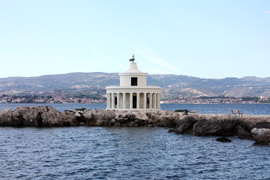
The original building dates back to 1820, but destroyed by the earthquake, it was rebuilt in modern times according to that which was his old plant.
We recommend you to go to this place at sunset as seen with the light colors of the sunset gives very romantic connotations.

MEMORIAL OF ITALIAN ACQUI DIVISION
In Argostoli, at the end of the peninsula there is the memorial monument of Italian Acqui Division and the pit where they were shot and then let the remains of part of the 136 officers.
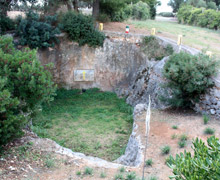 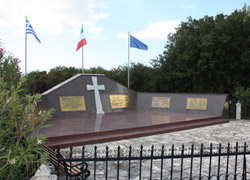
You have to follow the coastal road that comes before the lighthouse of Agioi Theodori and then back to back to Lassi. In the hilly area along the road you will see indications to see both the monument and the pit next to.
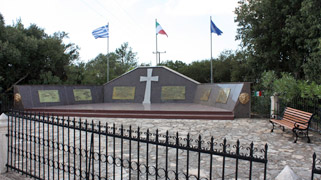 The Division Aqui was in Kefalonia during the Second World War and the armistice of 8 September found itself against the German army. The Division Aqui was in Kefalonia during the Second World War and the armistice of 8 September found itself against the German army.
The Division Aqui unlike other decided not to surrender to the Germans but to fight but did not have the military support of the Allies resisted so little.
On September 21, surrendered planning to still be protected by the Geneva Convention instead within two days on 25 and 26 September were shot all official and unofficial.
A reminder was created this monument right next to the pit where they were piled the bodies of the Italian officers.
The monument, which sets out six large plates the names of all the fallen.
Thousands of Italians were killed in Kefalonia and it was an event so heinous that still talk about it.

AGHIOS GERASIMOS CAVE
The story of St. Gerasimos Kefalonia, tells about of a man, Gerasimos, who was born into a wealthy aristocratic family on the island of Kefalonia, took the vote and became a monk at Mount Athos.
After the monastic experience was followed by a period of pilgrimage which brought him to Jerusalem for 12 years, then for a period on the island of Crete, the most in Zakynthos and finally, in 1555, again in Kefalonia.
Once settled in Kefalonia, tradition tells us that he spent his first five years in a cave on the island southeast of the city of Argostoli, in the area of Lassi, where he practiced agriculture and led an ascetic life.
Visiting hours: 7.00- 13.00 and 15.00-21.00

MYCENAEAN TOMB OF POROS
A discovery made in recent times (1992-94) that has discovered, near Tzannata, an ancient Mycenaean tomb built in that time has circumstances to understand that this area was inhabited by man since ancient times.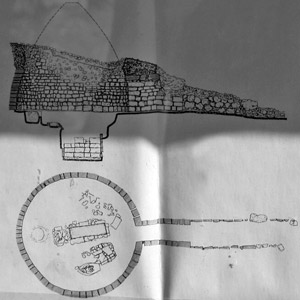
The tomb is the largest and the best preserved of all those that have been found on the island of Kefalonia.
The tomb has a diameter of 6.80 m and a preserved height of 3.95 m, and was built on the site of another, smaller tomb that collapsed as a result of some unkonwn cause about 1350 BC.
The poros stone used in the earlier tomb can be seen incorporated into the tholos of the later one.
The grave contained the remains of the person for whom the later tomb was built and the partly destroyed graves built of white limestone belonged to other officials in the area, who lived about the first quarter of the 12th century BC.
Near the tholos tomb a built, quadrilateral chmber tomb, which had been used as an ossuray, was located and excavated. During the excavation, the bones of 72 people were found and transferred here in the ossuary with a few of their grave offerings (fine examples of pottery, jewellery and sealstones with interesting representation).

ROMAN CEMETERY OF FISKARDO
The Roman cemetery of Fiskardo was discovered in 1993 and dates back to the Christian Era (II-IV century AD). 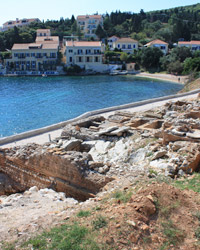
During the excavations have been discovered 47 tombs and you think that the cemetery is much more extensive and continues under the current coastal road.
There are different types of tombs:
- in tiles (the dead lying in a pit above to a layer of tiles and it is also covered)
- burial jar (they are very large ceramic pots used as burials of infants and children)
- rectangular tombs which include a pillow stone
- monumental tombs (actual rooms even with the door in stone)
- sarcophagi (made by a single piece of stone)
I found two sarcophagi and the sides have representations in relief Hell, one shows the abduction of Persephone.
Many of the graves are found whole families were buried together, and in some, the most sought after, were also found objects such as mirrors, earrings, bracelets, vases, coins and much more.

ANCIENT ACROPOLIS OF SAMI
The ancient acropolis of Sami was discovered just north of the tourist village of Sami, at the foot of the hill of Agioi Fanendi.
According handed down by Thucydides, Sami was already one of the four ancient prosperous city on the island of Kefalonia, was a prominent and prosperous city, inhabited since Paleolithic times.
In classical times the city of Sami went through a period of great prosperity through the development of its business activities and export of timber from Mount Ainos (Enos).
Excavations carried out in recent times have brought to light the two citadels or Acropolis of Sami, parts of an ancient aqueduct, traces of what might have been a theater and part of a Roman building known as "Rakospito."

RUINS AT SKALA
In the south of the island of Kefalonia, not far from the beautiful pine forest and beach of Skala were discovered in 1957 the remains of an ancient Roman villa. The house is believed to date back to the third century BC was decorated with large mosaics and baths and has been estimated that the owner was a Roman aristocrat.
Also near the village of Skala were discovered the remains of a Doric temple dedicated to the worship of the god Apollo dating from the fifth century.

THE CYCLOPEAN WALLS
Here in Kefalonia, just 3 km east of the capital Argostoli, there are the ruins of the ancient Krani, mainly consisting of walls with huge blocks of stone that were created in the seventh century b.C.
Krani is at the end of the bay of Koutavos, built on the hills overlooking the plains of the region Krania.
According to the respected archaeologist Marinatos, the plain of Krania was also the home of the ancient city.
Are still clearly visible large sections of walls that remind us of the ancient Greek art in being able to build fortifications are known as "Cyclopean walls" because of the large blocks of stone that form and go back to the Mycenaean period.
On the south side of the hill, which is called Riza, were found several burial chambers of the pre - Mycenaean.
Riza was used as a cemetery for the city of Krani.

|

